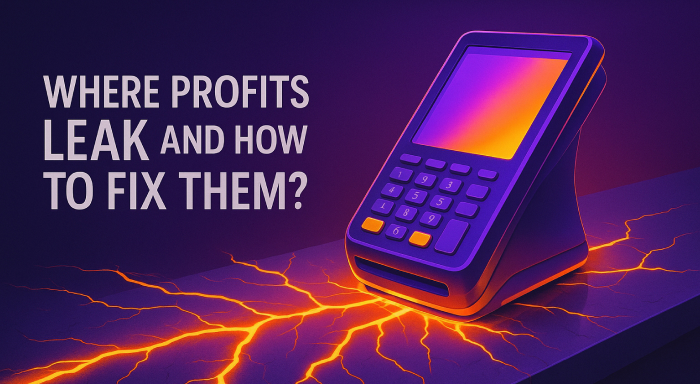Profit never really disappears because of a single mistake. It leaks through small oversights, such as a sluggish checkout, a missed part on a ticket, and a price guessed under
Profit never really disappears because of a single mistake. It leaks through small oversights, such as a sluggish checkout, a missed part on a ticket, and a price guessed under pressure, just to name a few. Multiply those minutes and errors across a week, and you will notice the margin on otherwise solid jobs shrinks quickly. So, what’s the fix? Simple, it’s the combination of process and tools. You should pick a POS system that speeds payment, makes parts visible, and keeps pricing consistent. It should also give clear prompts to advisors so fewer details are missed. With the right POS system for repair shop operations, approvals move faster, disputes drop, and daily revenue becomes steadier without longer hours or extra staff.
Where Profits Leak and How to Fix Them

Margins often slip in small places around the counter that are easy to fix. A reliable POS system allows repair shop owners to tie payment, parts, and pricing together so they can make informed decisions without having to worry about any slipups. The following are a few ways that will help you turn the counter into a profit center without longer hours or extra staff.
1. Speed Up Checkout and Reduce Walkaways
No one likes long lines and wait times. It makes customers second-guess pickup. Therefore, you will need fast ways to take payment without retyping details. Always remember that momentum at the counter sets the tone for everything after. You should offer facilities such as tap to pay, store cards for repeat customers, and pay-by-link for remote approvals. Also, preload tax, fee, and tipping rules so totals land right the first time. Fast checkout cuts walkaways, finishes jobs per day, frees bays sooner, and reduces awkward haggling at pickup by keeping numbers clear.
2. Make Inventory Visible and Margin Honest
Margins are lost when parts hide on shelves or live in someone’s head. If the counts lag, you can expect the invoices to drift and small misses to occur. You wouldn’t want that, as it will directly affect the store’s profitability. So, what should you do? Well, for starters, know that visibility is the start of honest pricing. You should receive stock against purchase orders, record landed cost, and attach reserved items to tickets when work is scheduled. Also, it is ideal to establish reorder points according to your vendor’s lead times. This will help you prevent dead stocks and rush buys. Moreover, it is critical to track returns on the same record so credits and refunds land on the job.
3. Hold Pricing Steady Under Pressure
Busiest hours can easily tempt you enough to offer quick discounts or off-the-cuff quotes. But here’s the thing: if you don’t have any guardrails in place, this temptation can easily cost you your margin. You should put some structure around price decisions so the right number appears fast.. You should build a price book that includes labor time bands, bundled kits for common jobs, and auto-applied fees with clear triggers. The estimates should be locked and must require the approval of the manager if they are above the thresholds. Use cost-linked parts to keep margins consistent when prices change.
4. Cut Payment Leakage with Tokenization
Declines and disputes waste time and erode margin, especially on repeat customers and remote pickups. Improving the credentials you send raises the share that clears on the first attempt and reduces chargebacks later. The right POS system for repair shop payments should support network tokenization. Tokens replace card numbers and keep details fresh, which eliminates fraud and lifts approvals. You will be surprised to know that Visa revealed that tokenized payments reduce fraud by 34% and increase authorization rates by 4.7%. Store cards, retry soft declines, and keep signatures so refunds and chargebacks land cleanly.
5. Use Reporting to Catch Discounts and Rework Leaks
Without tight reporting, small leaks hide in plain sight. Discounts that seemed harmless, rework hours that never got billed, and parts write-offs add up quietly. Put eyes on the numbers every day. Track discount rate by front desk, margin by job, refunds by reason, and unpaid balances by age. Flag tickets with manual price edits and require a note. Review a daily report in the morning huddle and a weekly roll-up. Fix the pattern, coach the habit, and protect profit.
Conclusion
It’s easy to make your repair business profitable as long as you practice the aforementioned tips daily. If you make checkout quicker, count your inventory, hold pricing steady, and harden payments against declines and disputes, you will notice your margin grow. You should treat the counter as a profit center and train techs to follow clean routines. Choose a good POS system for repair shop workflows that speeds approvals, ties parts to tickets, and keeps totals consistent without extra clicks. This will help you run your repair shop smoothly and profitably.
Related posts:
How to Create QR Code for Your Business: A Detailed Guide
Should You Support Internet Explorer in 2025 or Move On?
Respond to this article with emojis






